Thanks to my contributors!
This time, a roundup of news and views from my fellow Ball Publishing editors—after all, I’m not the only reporter and writer around this joint. Plus, I can’t be everywhere … although my friend Keith Cable, president of Dümmen Orange North America, was surprised a few weeks ago when he saw me in Iowa, when just a few hours earlier he’d read my “live” report from Michigan. I had to break it to him that while I’d sent the email that day, I had written it the day before and been in Michigan a week before that. (A little editorial slight-of-hand, you might say.)
Who is that masked trade show attendee?!
This first bit of reportage is from Managing Editor Jen Zurko, who made her first trip to the Farwest Show in Portland, Oregon, to dig deeper into the world of woody ornamentals.
It certainly wasn’t anyone from the Justice League or the Avengers—it was all of the attendees at the Farwest show in Portland, Oregon, August 18-20.
Days before the event, Oregon Governor Kate Brown issued a mask mandate for all indoor venues because of the rise in cases due to the Delta variant. (As I write this, Illinois just announced it’s going back to masks again, too.) We all had to wear masks, but it was worth it to host an in-person event, said Jeff Stone, Executive Director of the Oregon Association of Nurseries (OAN), which puts on Farwest.
“We wanted to make sure that we put on the safest show that we knew how that met the guidelines, not only of the convention center, but what the state imposed,” he said. “People were really hungry to get together. A lot of people haven’t seen each other in over a year.”
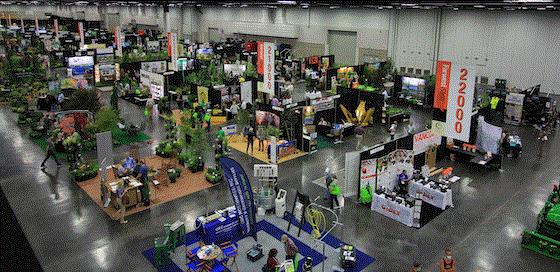
Once the mandate was announced, OAN made sure to let attendees and exhibitors know. They also ordered 17,000 masks so that people could take extras as they entered the trade show floor and there was plenty of hand sanitizer strategically placed throughout the aisles.
Like many events in 2020, Farwest was cancelled. OAN did put on a virtual program this past spring centered around their annual Nursery Guide, but it didn’t live up to the expectations that a live show provides.
“You have the advent of all the digital stuff, but still, at its heart, a trade show like this is hand-shake agreements. It’s seeing, touching, feeling the plants,” said Jeff.
To add to the headaches OAN already had while trying to plan a trade show around a pandemic that wasn’t going away, the city of Portland itself has been dealing with its own challenges following a summer of violent protests and riots.
“To be candid, Portland has had a tough image over the last year,” said Jeff. “And people don’t really know who’s causing the problems. I live in Portland and it’s really just over two blocks. But perception is reality, so we met with Travel Portland and Travel Oregon and said, ‘Look, you have an image problem. We need to clean this city up.’ Yes, we have a homeless issue here and it’s very complicated. People who live in rural areas don’t necessarily care what Portland’s problems are. All they know is what they see [on TV]. So we’ve worked very hard and they did some positive messaging for us about how Portland is welcoming.”
For the last couple of months, OAN staff would go into Portland to take short videos on their cell phones to help promote Farwest and show areas of the city.
“We’re seeing more families visiting and we want to show people that life is normal,” said Allan Niemi, OAN’s Director of Events.

“The right people are attending”
This was the 48th Farwest event, which started as a small regional show that kept growing, eventually outgrowing its space at the Memorial Coliseum, forcing OAN to move the show to its current home, across the street to the Oregon Convention Center in 1998.
As for attendance numbers, Allan said that Farwest saw over 3,500 attendees (the typical year sees about 5,000) and booth count was down 15%, which was mostly international companies.
“We’re down due to COVID,” Allan admitted. “We normally attract people every year from 20 or more countries and 45 different states that come to our show. But the thing that I heard at Cultivate and Jeff heard from [the Texas Nursery & Landscape Association] is the right people are attending, as far as the buyers. They’re the ones who really need to come here and do business. Those are the folks that are making it to trade shows right now.”
Though OAN’s key members are tree and shrub growers, there are a few annuals and perennials exhibitors at Farwest. It’s always been much more of a “green” show than a hardscapes one, said Jeff. And a brand-new segment that’s now part of the show that they’ve never seen before is houseplants.
“We’re starting to see an evolution this year of a lot more indoor plants,” said Allan. “We have 49 brand new exhibitors at the show this year—that right there shows the interest and the value of trade shows in general. I think that people want to be part of that hub. That’s one thing I’m excited about is that we are getting an infusion of new folks. And I hope that they do well. If they stay here maybe they’ll bring more.”
OAN decided to forgo the formal nursery tours this year—it was just too risky to plan—but they heard from many local growers who hosted dozens of private tours (including Matthew and me! See below.). They did keep their educational track, so that they could “feed attendees’ minds” with their wide range of speakers.
Despite all of the challenges, Jeff and Allan said that they’re pleased with how everything came together and that people were still able to come to Farwest.
“It really has been challenging. It’s been a time period of landmines,” said Allan. “We’ve been very fortunate with the members we have that make up our committees—it really does take a village to put on our event, especially through this.”
As the pandemic continues to be part of our everyday lives, organizations and companies are getting used to navigating through ever-changing guidelines and mandates. When I sat down with Jeff and Allan, the FDA was days from full approval of the Pfizer vaccine and vaccine mandates were already being announced throughout multiple industries and federal agencies. So I asked their thoughts on whether they think we’ll ever see hort and nursery events mandate vaccines or require proof of status.
“We’re kind of the last big event [of the year before MANTS], so it really depends what progresses between that time period during these next few months,” said Allan. “I hope that’s not necessary because logistically it’s a challenge. But at the same time, we’ve been able to overcome other hurtles [like dealing with the mask mandate]. We’ll just see if that becomes the next hurtle. If restaurants require it and people start getting used to doing it in their normal lives, that may carry over to events.”
“It’s going to take that and private employers requiring it for employees for it to trickle down to events like ours,” said Jeff. “We’re not going to be the leading indicator of that, but certainly if the whole tide goes out … I’m a big believer in personal responsibility. I would prefer for us to give that to individual choice. But that’s an interesting question. I think it’ll be driven a lot by venues following suit sooner than organizations.”
As for the future, Jeff and Allan said they’re optimistic. Sure, we’ve got our problems, but we’re lucky that OAN’s members—and really everyone across the industry—realize the benefits of being solution-oriented. We see where we want to be and then build the road to get there, said Jeff.
“There will be external factors—hopefully, that aren’t ice, wildfires, heat domes, COVID—because it’s been a tough beat. But what I see is people who are resilient and that’s what I’m proud of.”

Three nursery visits
Before the show, my pal Dr. Matthew Chappell—hort professor, extension researcher and editor of our Nursery & Landscape Insider newsletter—and I took a couple of days to visit some local Oregon nurseries.
I’ve been on many a greenhouse tour and most of the time you can squeeze at least four operations in one day. When you’re touring a nursery, which is typically over many acres requiring a van for transport, it takes many hours. Matthew and I would have loved to have visited more, including some garden centers, but there just wasn’t enough time. But we got the chance to visit three nursery operations and made the most of it. Here’s a quick snapshot of highlights and observations from all three:
Monrovia—Dayton
Jonathan Pedersen (President & CEO), Katie Tamony (Chief Marketing Officer) and Georgia Clay (New Plants Manager) were our hosts for our tour of their Dayton nursery, which totals about 1,100 acres and includes a tissue culture lab. Jonathan said that about 35% of all their propagation comes from TC.
Monrovia is known for its lineup of shrubs like crapemyrtles and rhododendrons, but during the last couple of years, they’ve really expanded their perennial plant offering. They had 245 new introductions this year and a lot of those are perennials. They don’t have an in-house perennial breeding program, so those genetics come from third-party breeders. They also grow some annuals at their locations in California and Georgia, so they’re in almost every segment, including conifers, succulents and houseplants.
If you’ve been paying attention when visiting your local garden center, you would have noticed that all of Monrovia’s shrubs are grown in branded pots. I specifically asked Jonathan about this because of a recent focus on requirements for growing in branded pots from other plant suppliers. Jonathan said that Monrovia has required growers to produce in their pots for 30 years.
“Was there pushback in the beginning? Yes,” he admitted. “But we also don’t have thousands of little growers we work with, we have 35 big growers, so it’s a different animal.”

Monrovia (continued)
Matthew and I got a peek inside Monrovia’s experimental trialing section, which they call “the bullpen.” Photos weren’t allowed, but we got to see a lot of interesting plants that may be coming down the pipeline for them, including some crops they’ve never offered.
We also got to see their proprietary trimmer in action. The “Mobile Work Station” developed by Monrovia’s Grower Technology division, prunes each shrub by turning it 360 degrees, so it gets all sides. Depending on the crop, some shrubs (like boxwood) need to be trimmed five times in order to push up more bottom branching. An AgriNomix fork spacer places, then spaces, the pots before and after they get a haircut.
“It would normally take six people to do it all; now it just takes one,” said Jonathan. “Without automation, we wouldn’t have gotten the work done. We were down 60 people [this year] because we couldn’t find them. It’s not because I don’t want to give people jobs; I just can’t find them.”
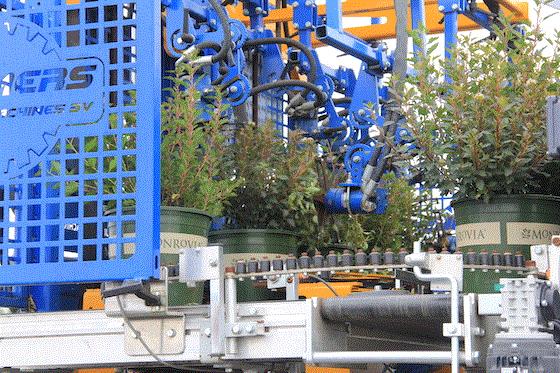 Little Joker Ninebark getting their 360-degree haircut. Once they go through the trimmer, they get picked up by an AgriNomix fork spacer and placed back in the field.
Little Joker Ninebark getting their 360-degree haircut. Once they go through the trimmer, they get picked up by an AgriNomix fork spacer and placed back in the field.
As far as Monrovia’s top sellers, boxwood is still No. 1, but after that it depends on where you are in the country. In the Pacific Northwest, Jonathan and Katie said they’ve noticed more of a shift toward drought-tolerant plants (for obvious reasons—more on that below), but also on natives and plants for pollinators. Plus, edibles like fruit shrubs and trees have become more popular, too.

J. Frank Schmidt & Son—Boring
I laughed when I read Jen’s title—it read like a Vic Ball headline if Vic hadn’t been impressed by the nursery.
I was completely out of my element here because this nursery is strictly trees—a segment I’m not as familiar with. But Matthew was rattling off species and cultivar names like a tree savant as we toured with Director of Communications Nancy Buley.
J. Frank Schmidt is celebrating 75 years this year and it’s still one of the only nurseries in the country that focuses solely on trees, growing over 500 varieties. Nancy said that having their own in-house breeding sets them apart. Recently, they’ve been breeding trees that have more predictable forms and shapes, especially for urban areas that don’t have the space for trees to spread out.
Some of the newer cultivars from J. Frank Schmidt’s own breeding include:
Sparkling Sprite Crabapple (I’m told it’s one word) doesn’t sucker and has clean foliage that’s scab resistant. The small green fruit turns orange as it ages. And you don’t have to prune it. This specimen was planted in 2018.
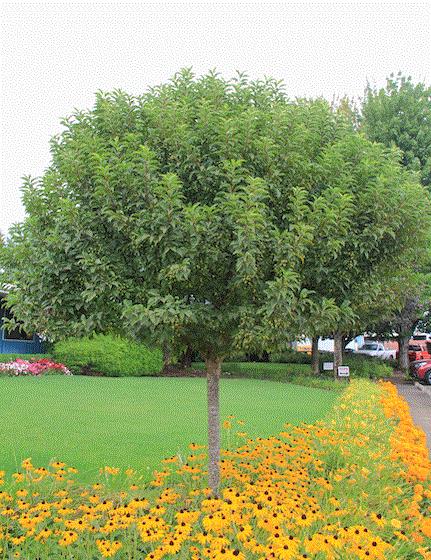
Sparkling Sprite Crabapple
Raspberry Spear Upright Crabapple is a breeding breakthrough because it’s the first, true columnar crabapple, which took a long time to produce. I loved this one because of the small, dark fruits that look like grapes.
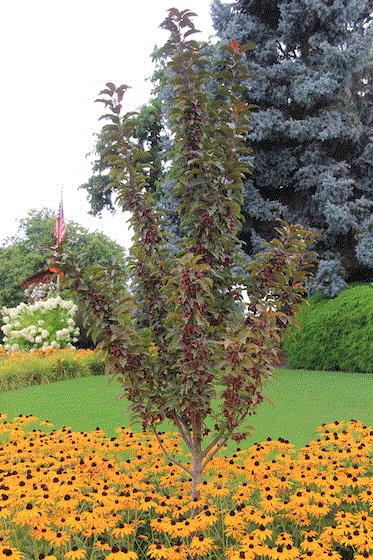
Raspberry Spear Upright Crabapple
Crimson Sunset Maple was a 40-year project for Keith Warren, their breeder who recently retired. Keith started crossing an Acer truncatum (Shantung maple) with an A. platanoides (Norway maple) to get a maple that’s both heat and cold tolerant. J. Frank has 20 trial location sites all over the country and Crimson Sunset did just fine in Fargo, North Dakota.
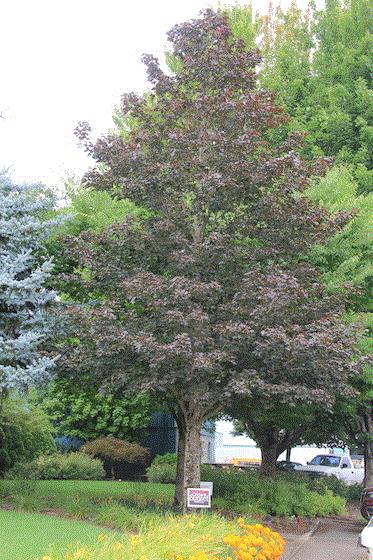
Crimson Sunset Maple
Dr. Seuss couldn’t have drawn a more perfect tree than Emerald Avenue Hornbeam because it doesn’t have to be pruned to get its beautiful teardrop-shape. The leaves turn yellow in the fall and it’s hardy to Zone 5. This one was planted in 2009.
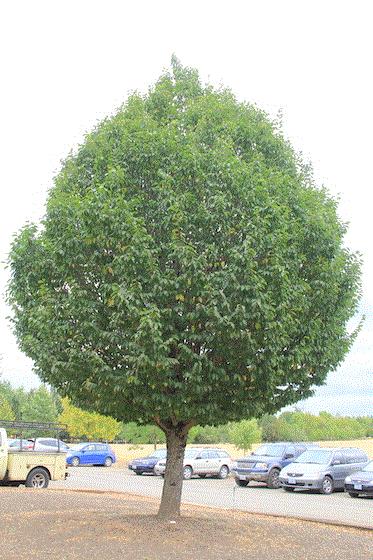
Emerald Avenue Hornbeam

Bailey—Sauvie Island
Bailey Nurseries has multiple production locations—in Minnesota, Illinois and Oregon—and the Sauvie Island one is for bareroot production only. Here, everything is planted and when they’re ready to be placed in finished containers, they’re shipped to other locations. The fruit trees are shipped to Minnesota and then the flowering shrubs head to the nursery in Dayton, Oregon.
Production Manager David Pond drove Matthew and me around their 1,200 acres, taking us on a very eclectic tour. I say that because it seems that Bailey has their hands in many types of nursery production.
One such project is their new venture into hazelnuts. In the fall of 2016, David said that they planted 95 acres of hazelnut trees on some excess land they weren’t using. The goal was to invest in something different, to diversify and “make our own land more useful,” he said.
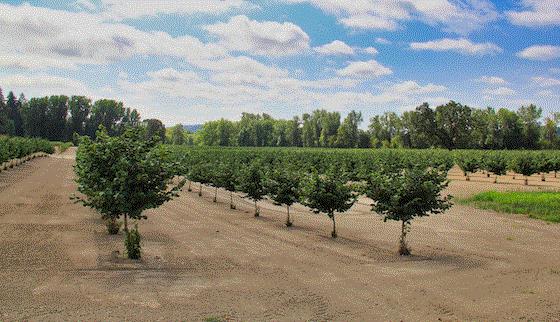
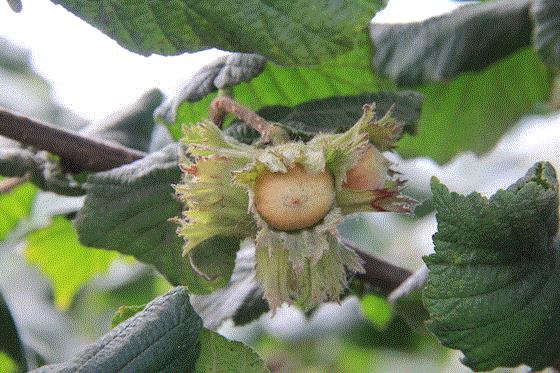 But they’re not selling finished hazelnut trees to their customers—they’re growing these just for the nuts, which they harvest and sell to George Packing Company, a local Oregon hazelnut grower, who then distributes them to commercial nut packaging companies.
But they’re not selling finished hazelnut trees to their customers—they’re growing these just for the nuts, which they harvest and sell to George Packing Company, a local Oregon hazelnut grower, who then distributes them to commercial nut packaging companies.
Although they just started with the project, they’ve already increased production to 210 acres. It takes four to five years before the trees are ready to harvest, so they really just have to maintain them until they’re ready. And it doesn’t take much labor to harvest the nuts—David said it only takes about five workers, plus gravity helps since the nuts tend to fall to the ground. And since they have a hard shell, you don’t have to worry about bruising or dirt. (Alas, there weren’t any ready for harvest, so we couldn’t taste-test them.)

On the climate
One final note: I did ask the nurseries about the two extreme heat waves the Pacific Northwest experienced in June and how they handled them.
For Bailey, David said the fact that they have drip irrigation lines buried 7 in. down into the soil “saved our bacon” during the heat waves. And they used heavy-duty sprinklers for the rows that didn’t have drip lines.
Monrovia had to deal with a lot of scorched plants, too. Unfortunately, Jonathan believes that extreme fluctuations in weather will be a regular occurrence.
“The climate is definitely changing. You’d have to be foolish not to see that,” he said.
A pair from Tech on Demand
Senior/Digital Editor Bill Calkins has been overseeing our new Tech on Demand initiative, gathering and distributing the best timely technical information he can find. He’s following in the footsteps of George J. Ball himself, the founder of GrowerTalks and the Ball RedBook, who wanted growers to have the latest cultural information at their fingertips. We still do, whether those fingertips are turning pages or tapping a screen. Here are two cultural resources from Bill and Tech on Demand:
Poinsettia Production Video Series
Attention poinsettia growers! If you haven’t been following along in Acres’s sister newsletter, Tech On Demand, there’s an ongoing video series keeping you ahead of the game with your poinsettia production this year. Up to 13 videos now, the series continues to help you and your team grow your best crop ever. It started all the way back at sanitation and receiving URCs, and took viewers through all of the propagation stages, into transplanting and is now following the crop in production.
The latest two videos are all about water quality, and media pH and EC. And just like the poinsettia season, the videos aren’t done yet and will take you all the way to the point you ship those bad boys out the door. Thanks to guest experts from Selecta One North America for sharing their knowledge via this series. To help you deliver this info with your team, remember all of the poinsettia videos are now offered in a dedicated Tech on Demand POINSETTIA PLAYLIST on YouTube.
At-Risk Crops Video Series
Another critical topic addressed by Ball’s Tech On Demand team includes crops with inherent pest or disease problems. We call them at-risk crops. The good thing is, these crops can be successfully produced when appropriate control strategies are followed. Similarly, disease outbreaks and losses are usually traced back to a failure to appropriately manage the risks associated with specific crops.
There are more than a dozen crops covered and they’re organized into a handy YOUTUBE PLAYLIST. Before binge-watching all of them, be sure to start with the OVERVIEW VIDEO. This kick-off video digs into ways to manage the Disease Triangle: Pathogen, Host and Environment. It offers overall strategies to use when producing at-risk crops. Continuous management of the disease triangle, throughout the entire production process, is required to ensure success.
Once you view the first video, check out subsequent episodes on hosta, ornamental peppers, cabbage and kale, zinnias, pansies, tomatoes, geraniums, and more. Each episode will look at risk factors, as well as methods of control specific to the crop.

You respond
Some thoughts from you about some of the topics I covered last time: chlorpyrifos, invasives and that nasty article about houseplants.
Thanks for providing the info on Chlorpyrifos in our industry. I’ve been watching the articles in the Michigan Farm News from my Farm Bureau membership with headlines like “EPA ban on chlorpyrifos devastating for Michigan farmers,” so it was good to hear how it will affect us.
According to these articles, there is still a point of concern for all of us, even if not in regards to this specific chemical: Apparently, the EPA didn’t follow normal procedural guidelines in this decision, and if they continue to do this, it could end up hurting us on some other chemical that we might need. (“Reaction pours in after EPA revokes tolerances for popular pesticide”— Michigan Farm News)
As for Imperata, we are one of those growers that continues to grow and sell the rubra or Red Baron cultivar. Legally, I might add. Only the straight Imperata cylindrica is completely banned. The cultivar is allowed through a special licensing process. Every three years we have to renew our license and each state is allowed to accept our application (if they do nothing, it is a denial.) As of the last renewal, only Michigan, Indiana, Wisconsin, Ohio, Nebraska and Connecticut accepted it. Each state has specific guidelines on what we have to do with a sale to that state, but basically we have to include a copy of the license with the sale and make it very clear to the purchaser that the plants can only be planted in their state and cannot be resold or transported to another state.
As for its aggressiveness/invasiveness, we have it growing uncontained in several of our stock field locations and it is only a moderate spreader. Whether or not the seeds are viable is really irrelevant because it doesn’t bloom. In other words, it is far less “invasive” than many other plants regularly grown, such as pennisetum and miscanthus, or even natives like many of the carex species, not to mention the four major traditional groundcovers (vinca, pachysandra, ivy and wintercreeper.) In fact, in one of our stock fields, we have the native beach grass (Ammophila breviligulata), native Carex emoryi and the Imperata Red Baron all growing just a few rows apart, and the Imperata is the least aggressive.—Homer Trecartin, Jr., Twixwood Nursery, Berrien Springs, Michigan

You respond (continued)
Not a grower, just a retailer. We MUST police our industry for the sake of our customers who may not know as much as we do about some of the plants they think they want to plant. Here at JB Hostetter, we will not sell anything we know is on the banned list, or bamboo, cattails, or the worst invasive of all, in my opinion, Houttuynia cordata. When customers ask for no-no plants, we take the time to explain why we don’t and won’t sell those plants. (Lest I come off as holier than thou, I admit we do sell buddleia, which can be a plague if the seedlings are not rogued out!)—Gayle Lawrence, JB Hostetter & Sons, Mount Joy, Pennsylvania
I appreciate you bringing up this issue. I am far from an expert, but if we really want to be known as a “green” industry as opposed to just being a “green-washing” industry we should take this seriously.
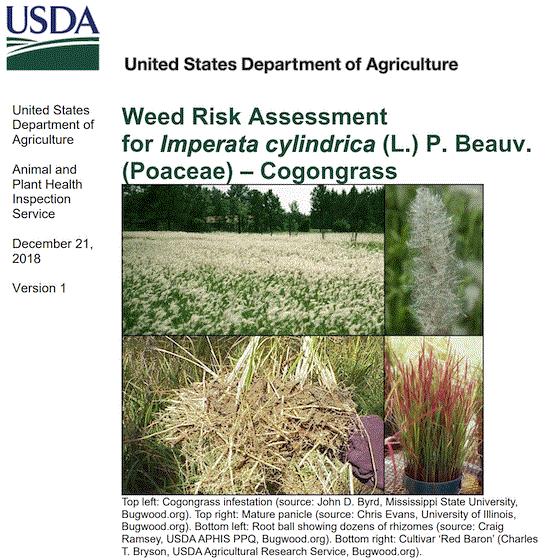
This seems to indicate that this particular plant certainly has the potential to do a lot of damage as far north as Canada. From what I’m reading, it’s already listed as a species by the feds that should not be sold. I have to question why Paul Pilon would indicate it’s okay to produce and sell this species in some states while knowing of the federal regulation.—Bill Carter, Prairie Moon Nursery, Winona, Minnesota
This item is still under discussion here at Walters Gardens—Imperata is definitely invasive in warmer climates, but not so much further North, such as the Midwest where we are based. There are a few states that ban shipment of both and we comply with those restrictions! It will be interesting to see if anything changes in terms of how many states start banning this and other [invasives], such as miscanthus.—Laura Robles, Walters Gardens, Zeeland, Michigan

Finally …
One last letter, in response to that hit piece on the so-called industrial farming of houseplants:
I think we all have had situations where the “world” finds ways to attack plants. For me, it always seems to be someone finding another way to tell me how bad turf is, and how the industry wastes water and pollutes the ecosystem with chemicals just to have nice grass. It’s too bad that the turf haters don’t look at the benefits of a healthy lawn and that it does not take a great amount of effort to have a nice lawn.—Rob Welsh (a turf specialist fighting the war in support of turf), School of Horticulture, Kwantlen Polytechnic University, British Columbia, Canada
See you next time!

Chris Beytes
Editor
GrowerTalks and Green Profit
This e-mail received by 25,237 loyal readers!
Thanks to my loyal sponsors, who help me reach the 25,237 readers of Acres Online in 66 countries. Want to be one of them (a sponsor, that is)? Give Paul Black a shout and he'll hook you up.